Biology-checklist sac , DNA, genes, and chromosomes, Genotypes and Phenotypes, Cell cycle and replication, DNA, genes, and chromosomes, Pedigree crosses and Pedigrees
1/163
There's no tags or description
Looks like no tags are added yet.
Name | Mastery | Learn | Test | Matching | Spaced |
|---|
No study sessions yet.
164 Terms
Characteristics of prokaryotic cells
Prokaryotic cells are simple, single-celled organisms with the following characteristics:
No Nucleus: Their DNA floats freely in the cell.
Small Size: They are smaller than eukaryotic cells.
Cell Wall: They have a protective outer layer, usually made of peptidoglycan.
Cell Membrane: They have a membrane that controls what enters and exits the cell.
No Organelles: They lack structures like mitochondria or the endoplasmic reticulum.
Ribosomes: They have small ribosomes for making proteins.
Flagella: Some can move using a tail-like structure called flagella.
Examples of prokaryotes include bacteria and archaea.
Eukaryotic cell characteristics
Eukaryotic cells are more complex than prokaryotic cells and have the following characteristics:
Nucleus: They have a membrane-bound nucleus that contains DNA.
Larger Size: Eukaryotic cells are generally larger than prokaryotic cells.
Organelles: They have membrane-bound organelles, such as mitochondria, chloroplasts (in plants), and the endoplasmic reticulum.
Cell Membrane: They have a cell membrane that controls what enters and exits the cell.
Cytoplasm: The gel-like substance inside the cell where organelles are located.
Ribosomes: They have ribosomes for making proteins, which are larger than those in prokaryotes.
Cell Division: They reproduce by mitosis or meiosis, which involves a more complex process than binary fission in prokaryotes.
Examples of eukaryotic cells include plant cells, animal cells, fungi, and protists.
DNA definition
DNA (deoxyribonucleic acid) is a long molecule that is comprised of two strands that form a double helixIt codes for proteins necessary for development, function and growth of living organisms, as well as viruses.
where is dna found in eukaryotic cells
the nucleus
where is dna found in prokaryotic cells
Prokaryotic DNA is not contained within a nucleus, but floats around in a region of the cytoplasm called the nuceloid
Differences between prokaryotic and eukaryotic cells
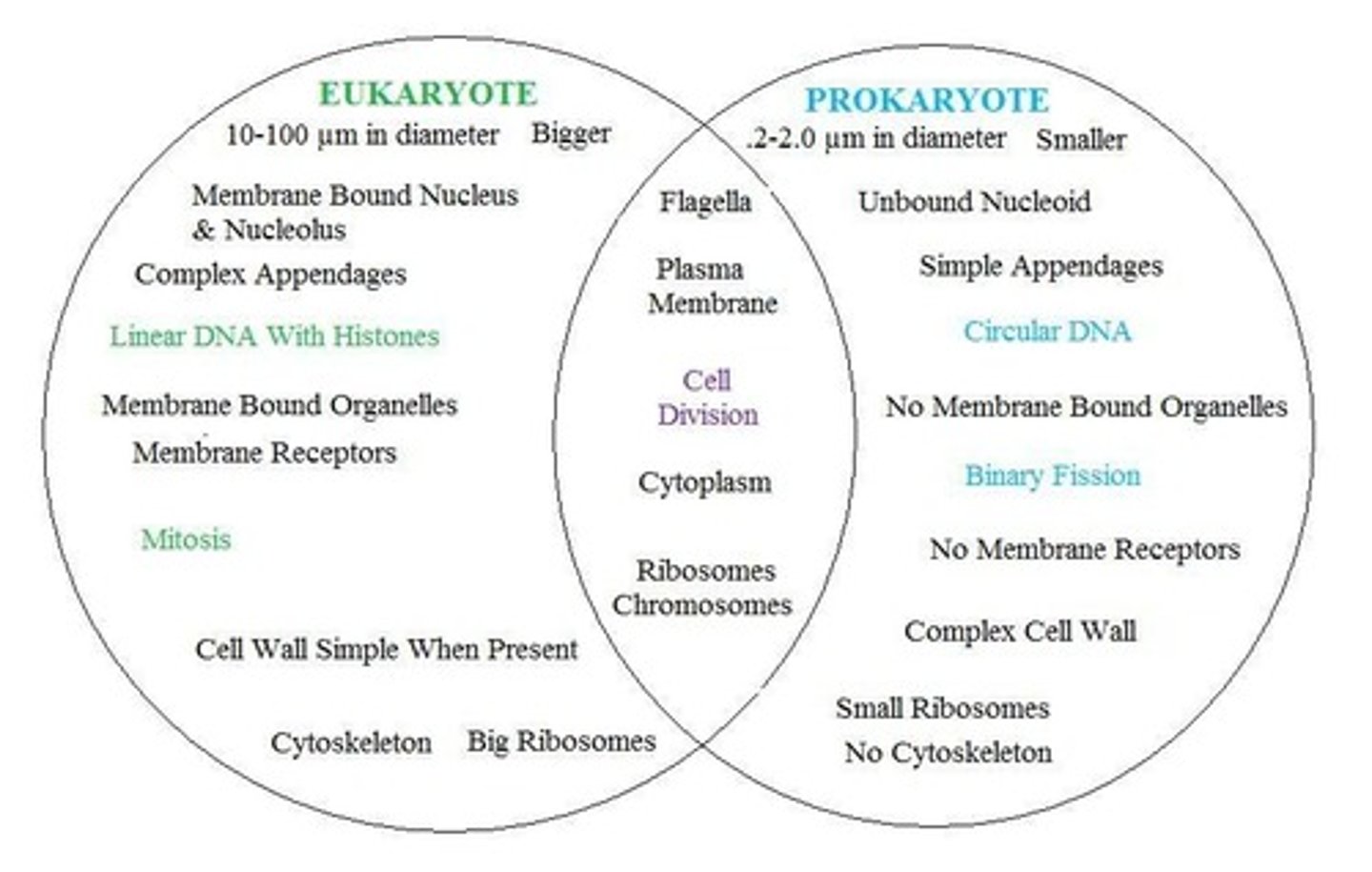
what is a somatic cell
- All nucleated cells that are not gametes (eg, skin, muscle etc.)
- Are described as "2n"
- Have 46 chromosomes in humans
What is a gamete
-are formed from germline cells
-sperm and egg
-are described as "n"
-have 23 chromosomes (in humans)
What is a germline cell
A germline cell is a reproductive cell, such as a sperm or egg cell, that carries genetic information to the next generation. These cells have half the number of chromosomes (haploid) compared to somatic cells, which allows them to combine during fertilization to form a new organism with a complete set of chromosomes.
What is DNA
DNA (deoxyribonucleic acid) is a long molecule that is comprised of two strands that form a double helix
It codes for proteins necessary for development, function and growth of living organisms, as well as viruses.
What is a DNA's structure
DNA is made up of monomers (subunits) called nucleotides
A nucleotide is made up of 3 parts
- A phosphate group
- A pentose sugar (deoxyribose sugar)
- A nitrogenous base
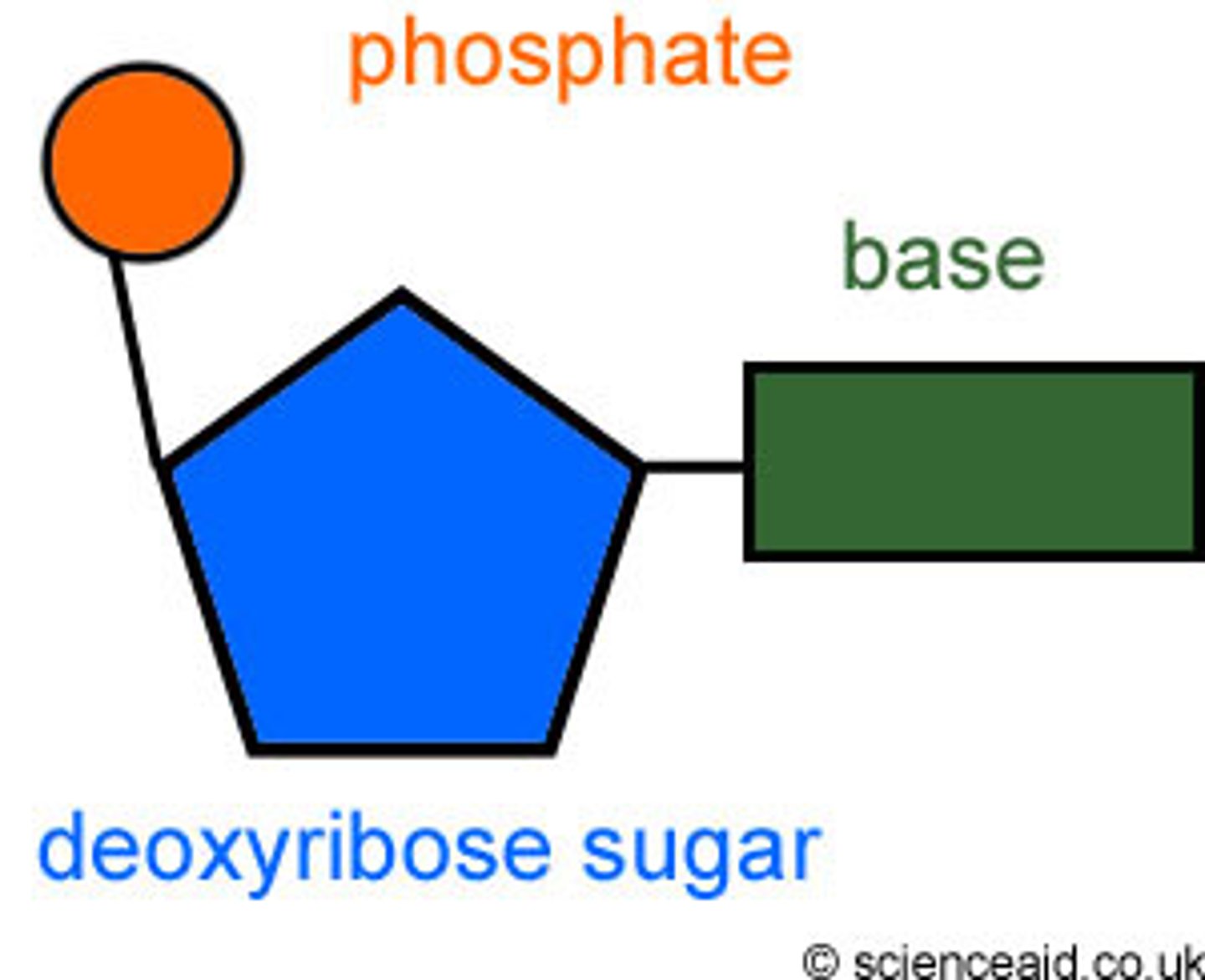
What are the nitrogenous bases
Adenine, and Guanine, which are purines
Thymine and cytosine which are pyrimidines
What bases pair together and why
Adenine pairs with Thymine as they make 2 hydrogen bonds
Cytosine pairs with Guanine as they make 3 hydrogen bonds
These bonds are all weak
What bonds does the deoxyribose sugar and phosphate group form?
strong phosphodiester bonds
What is the shape/ structure of DNA together by
"sugar-phosphate backbones"
Genes relationship to proteins
Genes are segments of DNA that code for making proteins
Proteins relationship to genes
Proteins are made by instructions provided by genes
Proteins do certain functions and work for an organism
Gene structure in Eukaryotic cells
Eukaryotic cells are made up of coding regions (exons) and non-coding regions (introns)

Gene structure in prokaryotic cells
Prokaryotic cells are only made up of coding regions (exons).
What is a chromosome
DNA wrapped around proteins known as histomes
What is a nucleosome and what do they do
8 histones with DNA wrapped around them is known as a Nucleosomes
they;
gene coding regions (exons)
non coding regions (introns)
Nucleosomes provide additional regulatory mechanisms to transcription and DNA replication by mediating the access of proteins to DNA
Chromosome structure
Chromatid- a strand of DNA
centromere- a protein that holds two sister chromatids together, which spindle fibres can attach themselves to during cell division
telomere- A region of repetitive nitrogenous bases at the ends of chromosomes
gene loci- the location of a certain gene, the same across all organisms of the same species
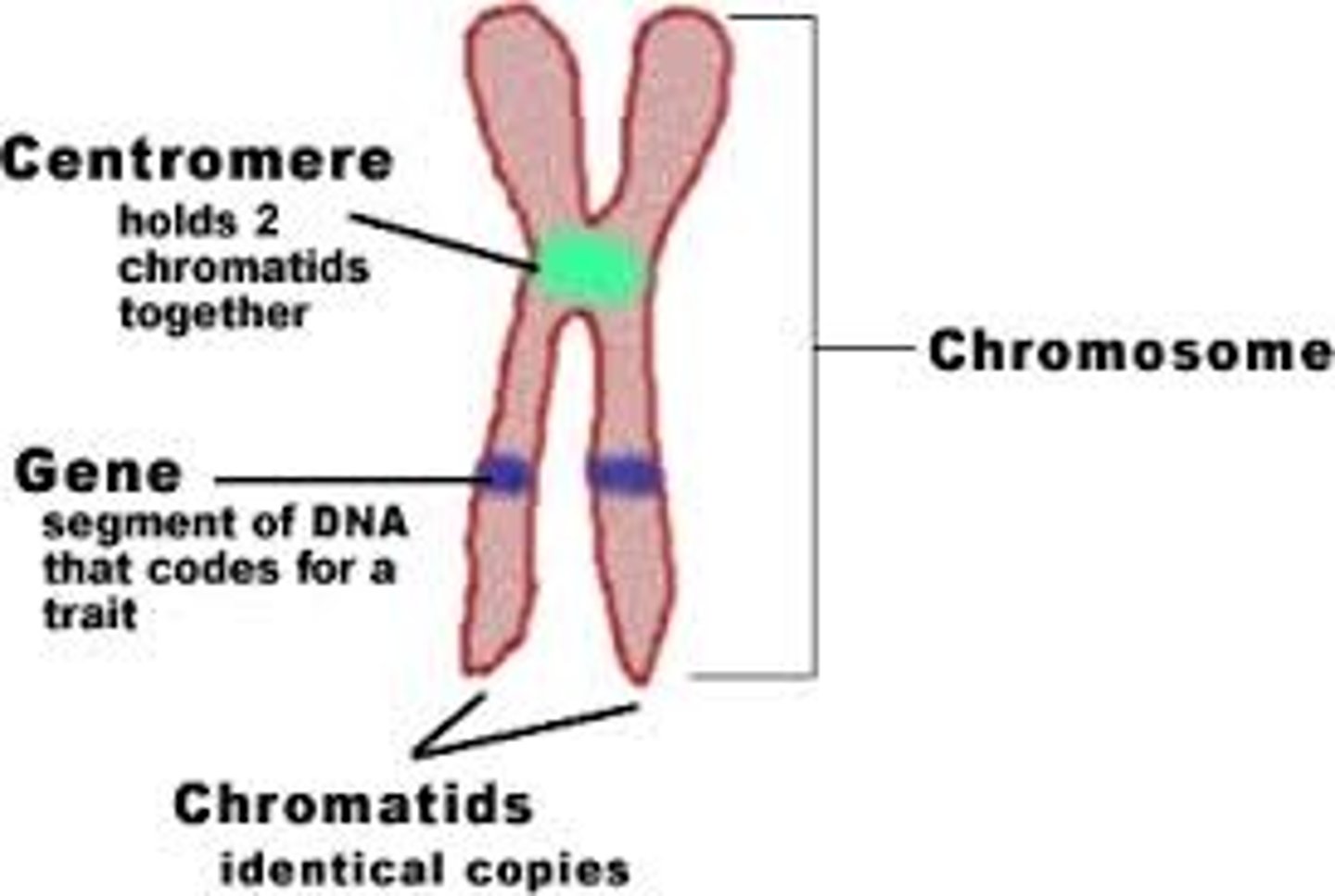
Prokaryotic vs Eukaryotic chromosmes
Prokaryotic chromosomes are
-circular
-double stranded
Eukaryotic chromosomes are
-linear
-double stranded
-DNA wrapped around histones
What is a genome
The complete set of genes present in a cell
What is a proteome
The complete set of proteins expressed by a cell
What are alleles
Alleles are alternate forms of a gene
-offspring receive one chromosome from each parent and therefore one allele from each parent
-allele combinations determine what traits are expressed
-alleles create diversity

Why do scientists use approaches to bioethics and ethical concepts
They can be used when identifying a bioethical issue and deciding the extent to which the outcome of a particular course of action (the effect) or the action itself (the cause) is ethically acceptable.
Consequence based approach to bioethics
Consideration of the consequences of an action with the aim to achieve maximisation of positive outcomes and minimisation of negative effects
Duty/rule based approach to bioethics
consideration of the obligation people have to act in a particular way regardless of the consequences that may be produced
Virtues based approach to bioethics
Consideration of what a morally "good" person would do when carrying out an action
Integrity ethical concept
Commitment to knowledge, understanding and honest reporting whether results are favourable or not
Justice ethical concept
commitment to consideration of competing claims and the fair access to the benefits of an action
Beneficience ethical concept
Commitment to maximization of benefits and minimisation of harm
Non-maleficence ethical concept
commitment to not causing harm that is disproportionate to the benefit
respect ethical concept
commitment to consideration of beliefs, customs, and cultural heritage
What is a karyotype
A karyotype is a picture of an individual's full set of chromosomes- arranged in homologous pairs
How many pairs of chromosomes do humans have
-Humans have 23 pairs of chromosomes, one set from each parent (in total 46 chromosomes)
-22 pairs of autosomes and one pair of sex chromosomes
- Females have XX chromosome, and males have XY
What is a homologous pair?
Two chromosomes that share 3 structural and functional similarities
-same size
-same gene loci
-same centromere location
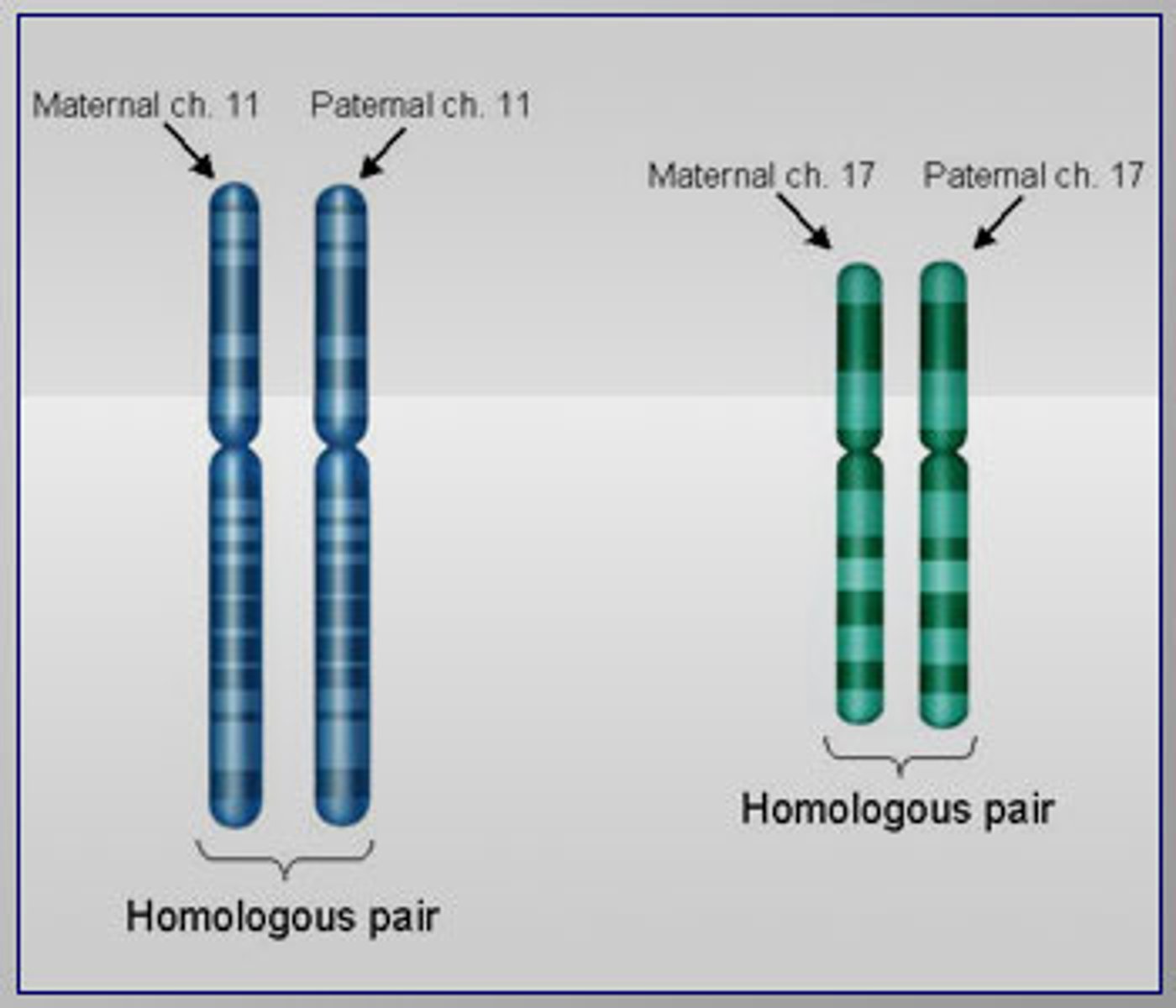
What is a somatic cell?
- All nucleated cells that are not gametes (eg, skin, muscle etc.)
- Are described as "2n"
- Have 46 chromosomes in humans
What is a gamete?
-are formed from germline cells
-sperm and egg
-are described as "n"
-have 23 chromosomes (in humans)
How is a karyotype made?
An image of a somatic cells chromosomes is taken through a microscope during prophase
Then the picture is cut up and rearranged by the chromosomes size and homologous pair.
Uses of a karyotype
Diagnostic tool, can assist in identifying chromosomal mutations or abnormalities
What is chromosomal block mutations
Changes to a chromosome structure through the addition, deletion, or rearrangement of nitrogenous bases/gene sequences
What are the chromosomal block mutations
Duplication, inversion, deletion, insertion, translocation

What is a nondisjunction
A process that occurs during meiosis (gamete/sex cell production) that results in chromosomes not separating properly
This results in aneuploidy, an abnormal amount of chromosomes, an individual receiving too many or too few.
What can allele be
Genes have different forms called alleles. An allele can be recessive or dominant.
What happens when a dominant gene is paired with a recessive gene
The dominant allele determines the characteristic
How can a recessive gene produce a recessive phenotype
the individual must have two copies, one from each parent
What is a genotype
The genotype is the set of alleles of a gene in our DNA responsible for a particular trait.
What is a phenotype
The phenotype is the physical expression, or characteristics, of that trait.
Genotype and phenotype relationship
A phenotype is how the genotype is expressed.

Homozygous
when both alleles are the same
Heterozygous
when alleles are different
AA
Homozygous dominant
Aa
Heterozygous
aa
homozygous recessive
Hemizygous
only one copy of gene instead of two. All the genes on the single X chromosome in males are hemizygous
Monohybrid cross
Mating between two individuals, investigating one gene

Male and female sex chromsomes
Male; XY
Female; XX
However, there are variations XXY (Klinefelter syndrome) or XO (Turner syndrome).
Sex linked
Why do X-linked recessive conditions occur more often in males?
Recessive trait cannot be hidden since there is no second allele
Whereas females with their second X get a second chance.
ONLY females can be carriers.
Sex linked conditions dominant/recessive
It must be carried on either an X or Y chromosome.
Typically, there are more X linked conditions
since the x chromosome it much bigger than the Y chromosome and therefore can carry more genes.
What are the mendal laws
Law of dominance
Law of segregation
Law of Independent assortment

What is the law of dominance?
In a cross of parents that are pure for contrasting traits, only one form of the trait will appear in the next generation. Offspring that are hybrid for a trait will have only the dominant trait in the phenotype.
What is the Law of segregation?
During the formation of gametes (eggs or sperm), the two alleles responsible for a trait separate from each other. Alleles for a trait are then "recombined" at fertilization, producing the genotype for the traits of the offspring.
What is the Law of Independent assortment
Alleles for different traits are distributed to sex cells (& offspring) independently of one another.
What traits don't follow the dominant/recessive rules of Mendels
Codominance
Incomplete dominance
Multiple Alleles
Lethal alleles
Multiple Genes (polygenic)
Environmental Factors (epigenetic)
What is incomplete dominance
Ratio will not fit the expected dominant / recessive pattern
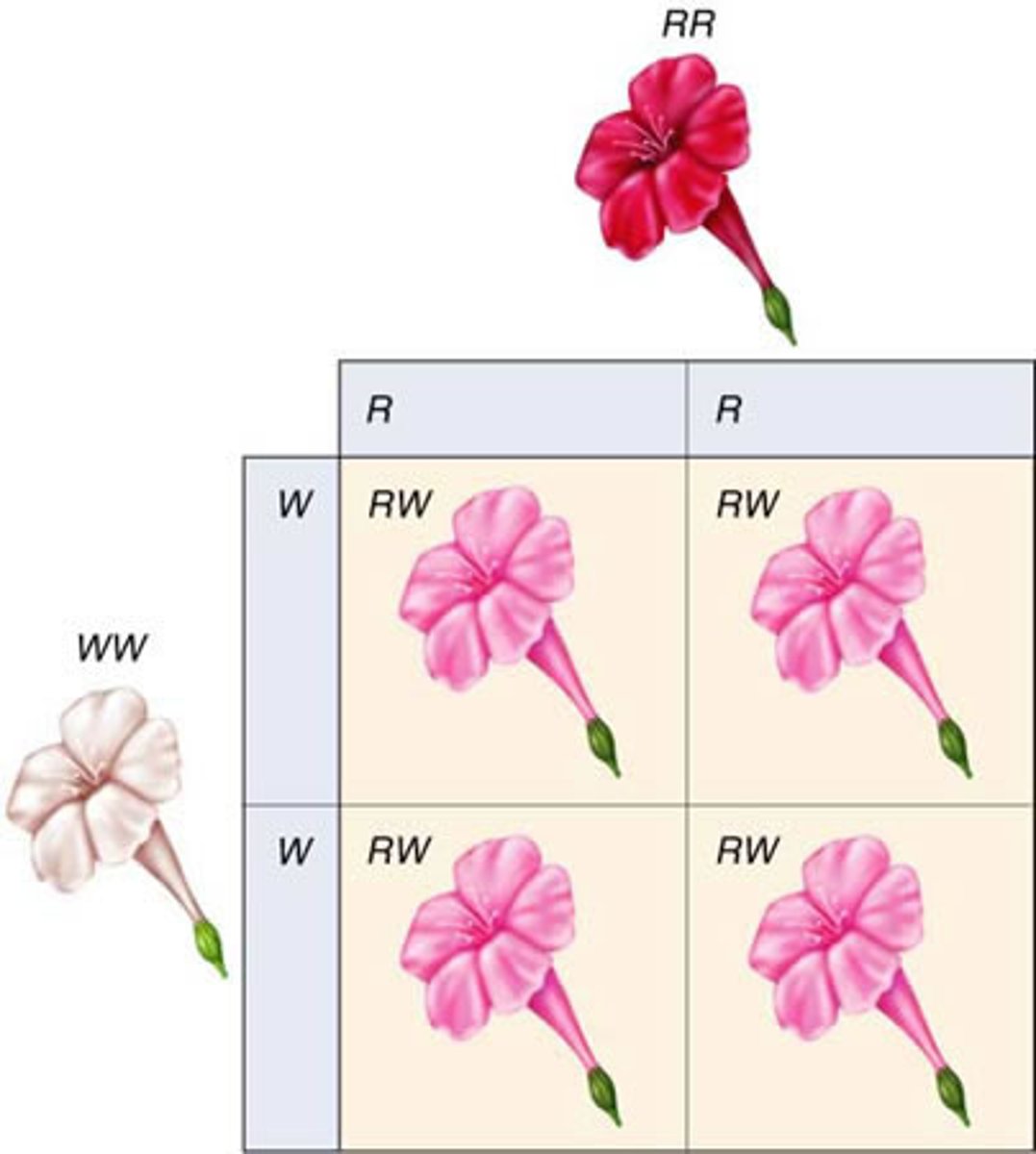
What happens in incomplete dominance?
A heterozygous genotype will produce a mixed phenotype.
This new, third phenotype is a blend of both parents, cannot clearly see either parental phenotype.
Since neither phenotype completely hides the other, there is no dominant or recessive allele.
Codominance meaning
Heterozygote produces a third phenotype. Both parental phenotypes are clearly seen.

Multiple Alleles meaning
It is possible that a trait has more than two (multiple) alleles that determine which phenotype is expressed.
Ex.
hair colour in rabbits
blood groups in
humans.

Multiple alleles and Codominance in ABO Blood Group
The ABO blood group system is the classification of human blood based on the inherited properties of red blood cells depending on the antigens A and B, which are carried on the surface of the red cells.
People may have type A, type B, type O, or type AB blood.

What is cellular reproduction?
Cellular reproduction is the process by which parent cells divide into two or more daughter cells
cell division in eukaryotic cells
- mitosis
- meiosis
Cell division in prokaryotic cells
binary fission
Why is it important for cells to reproduce
-cell growth and development
-asexual reproduction
- regeneration
-cell replacement
In the eukaryotic cell cycle, where do cells spend most of their time
interphase
Interphase stages
Gap 1 (G1) , Synthesis (S) ,Gap 2 (G2)
What happens in interphase stage G1
Cell growth, protein synthesis and duplication of organelles.
*if cell is not to divide again it will enter G0
What happens in interphase stage S
DNA is replicated and chromosomes are duplicated
What happens in interphase stage G2
cell growth and preparation for division
How long does the eukaryotic cell cycle take?
The cell cycle takes approximately 24 hours. G1 lasts about 11 hours, S phase about 8, G2 about 4 hours and mitosis about 1 hour
- Early embryonic cells are less than 30 minutes long
- Nerve cells cease division altogether and many liver, kidney, and lung cells divide only occasionally, as needed to replace cells that have been lost because of injury
Binary fission major steps
-Dna replication
-Elongation
-Septum formation
-Cell division
Binary fission allows for a single bacterium to replicate into a few million in a very short time span
What is mitosis
-The nucleus of a single cell divides into two identical daughter cells, containing a complete copy of the parental chromosomes.
-It occurs in somatic cells only, which make up the body tissues and organs.
-The produced cells are diploid, containing two complete sets of chromosomes
Mitosis stages
Prophase
Metaphase
Anaphase
Telophase
What happens in prophase, and chromosome numbers
Chromatin condenses into chromosomes, nucleus disappears.
Chromosome numbers (in humans)
Chromosomes; 46
Chromatids;92
What happens in Metaphase?and chromosome numbers
Chromosomes line up along the metaphase plate (imaginary plate)
Chromosome numbers;
Chromosomes; 46
Chromatids; 92
What happens in Anaphase?and chromosome numbers
Chromosomes break at centromere, and sister chromatids move to opposite ends of the cell
Chromosome numbers;
Chromosomes; 92
Chromatids;92
What happens in telophase?and chromosome numbers
The nuclear membrane reforms, nucleoli reappear, and chromosomes unwind into chromatin.
Chromosome numbers
Chromosomes;92
Chromatids;92
What happens in cytokinesis, and chromosome numbers
Myosin II and actin filament ring contract to cleave cell into two
Chromosomes = 46
(No chromatids - chromosomes are not duplicated in this stage)
What is cytokinesis
Divides the cytoplasm of a parental cell into two daughter cells.
Cytokinesis is different in animal and plant cells:
In animal cells a ring of contractile protein forms that constricts the cell inwards.
In plant cells a cell plate forms.
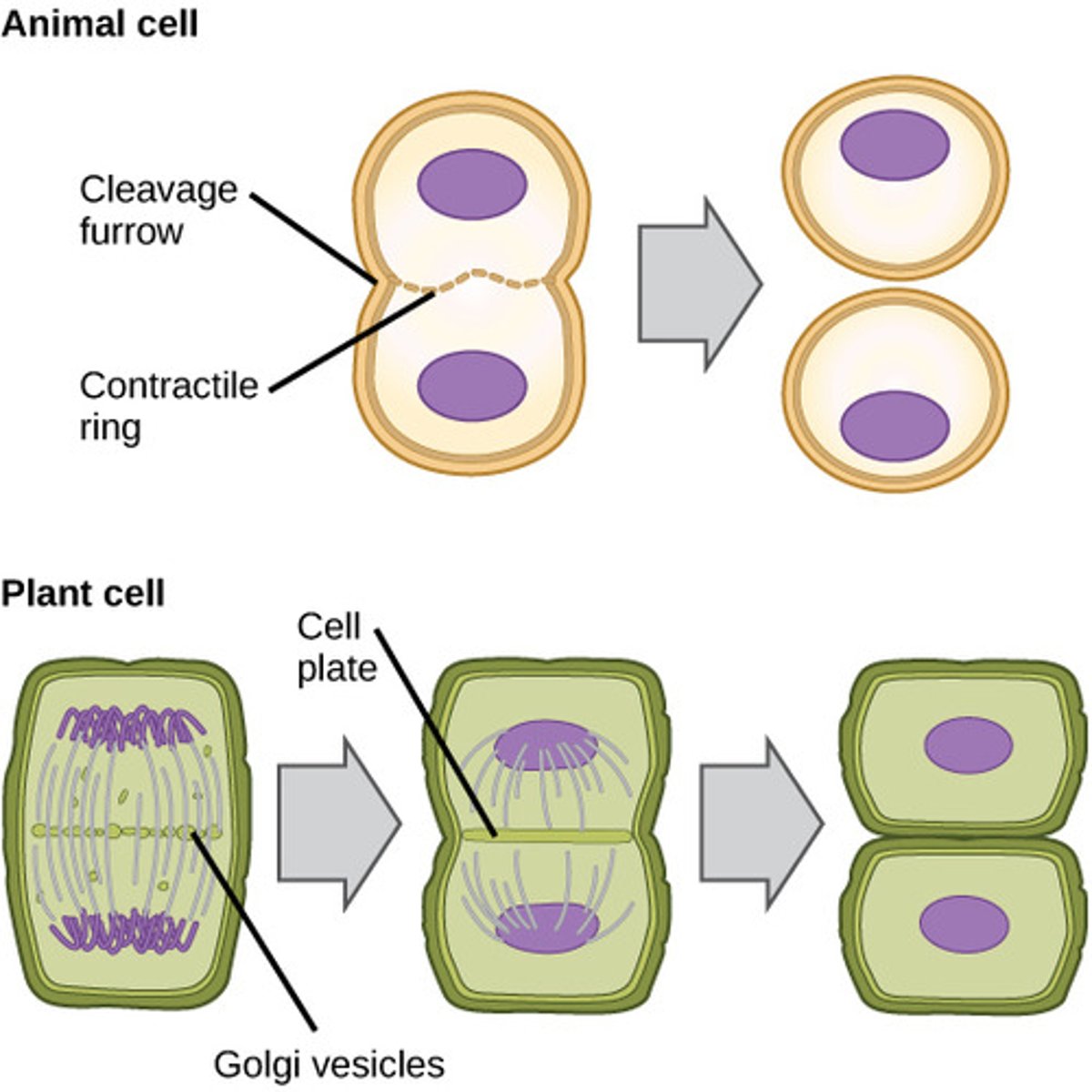
what is regulation of the cell
The cell cycle contains checkpoints that allow cells to ensure they replicate correctly.
If errors are detected, the cell can pause for repairs.
If the damage is irreparable, the cell will undergo apoptosis
What are the checkpoints in terms of regulation of the cell
G1 checkpoint to check for; nutrients, growth factors, DNA damage
G2 checkpoint to check for; cell size and DNA replication
Metaphase checkpoint to check for; chromosome spindle attachment
What is meiosis?
Meiosis is a process where a single cell divides to produce four different cells containing half the original amount of genetic information
It occurs in germline cells to produce gametes (sperm and eggs)
The daughter cells are haploid; containing one set of chromosomes.
What is the process of Meiosis
PMAT x2
What is the process of Meiosis in terms of PMAT x2

What is genetic variation
-Genetic variation is the diversity present in the DNA of a population.
-Genetic variation is advantageous as it allows populations to adapt to changing environments.
-If a population has more genetic variation it is more likely that some individuals in a population will possess -advantageous traits for their environment.
-This may lead to evolution.
Sources of genetic variation
1. Genetic recombination
2.Sexual reproduction
3.Mutations
What is genetic recombination
The regrouping of genes during the formation of gametes (meiosis)
What is sexual reproduction
reproduction involving the fusion of a male and female haploid gamete